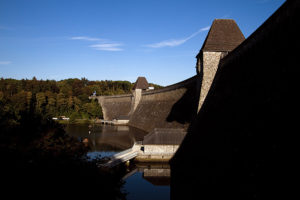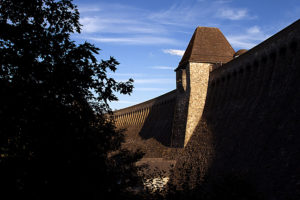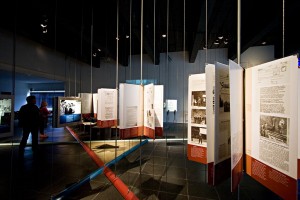 The Möhnetalsperre (literally “Möhne Valley Barrier”) is a dam and hydroelectric power plant in North Rhine-Westfalia, Germany. Built in 1908 – 1913, it bears little resemblance to today’s concrete dams. Instead, its use of natural stone for the barrier and slated roofs for the dam buildings in a traditional German style makes it seem to spring right out of a fairytale. It is also located in a hilly area covered in beautiful expansive forests. Today the dam is therefore also a popular excursion destination. Its appearance is at the same time graceful and imposing. The design was also adapted for another barrier built around the same time – the Edertalsperre, some 70 km to the southeast.
The Möhnetalsperre (literally “Möhne Valley Barrier”) is a dam and hydroelectric power plant in North Rhine-Westfalia, Germany. Built in 1908 – 1913, it bears little resemblance to today’s concrete dams. Instead, its use of natural stone for the barrier and slated roofs for the dam buildings in a traditional German style makes it seem to spring right out of a fairytale. It is also located in a hilly area covered in beautiful expansive forests. Today the dam is therefore also a popular excursion destination. Its appearance is at the same time graceful and imposing. The design was also adapted for another barrier built around the same time – the Edertalsperre, some 70 km to the southeast.
The Möhnetalsperre was built to regulate the water level of the river Ruhr, where large industries had sprung up that required a steady flow of water. It is also producing electricity through a hydroelectic plant.
 During World War II, the dam attracted the attention of the British Royal Air Force, which (wrongly) assumed that it was crucial for the water and electricity supply of the industry in the Ruhr area. In the night of the 16th May 1943, British bombers attacked the poorly defended dam along with two other dams, the Edertalsperre and the Sorpetalsperre. In order to make an attack on this type of edifice possible, British engineer Barnes Wallis had developed a new type of bouncing bomb specifically for this operation, which would be dropped off an airplane at low altitude and then bounce on the water (similar to throwing a flat stone) and jump across the torpedo nets which were installed in front of the dam. The bomb would then sink and detonate close to the dam. When the Möhnetalsperre breached, the devastating flood wave that followed killed around 1.600 people, mostly residents, prisoners of war and forced laborers in the towns below the dam. The incident therefore is an example of both collateral damage in war situations – i.e. the killing of innocent people as a “byproduct” of attacks on military targets – as well as (in a broader sense) the misguided use of human intelligence in war times – Wallis’ endeavor to develop a technical “solution” (developing a new bomb type) to a military “problem”.
During World War II, the dam attracted the attention of the British Royal Air Force, which (wrongly) assumed that it was crucial for the water and electricity supply of the industry in the Ruhr area. In the night of the 16th May 1943, British bombers attacked the poorly defended dam along with two other dams, the Edertalsperre and the Sorpetalsperre. In order to make an attack on this type of edifice possible, British engineer Barnes Wallis had developed a new type of bouncing bomb specifically for this operation, which would be dropped off an airplane at low altitude and then bounce on the water (similar to throwing a flat stone) and jump across the torpedo nets which were installed in front of the dam. The bomb would then sink and detonate close to the dam. When the Möhnetalsperre breached, the devastating flood wave that followed killed around 1.600 people, mostly residents, prisoners of war and forced laborers in the towns below the dam. The incident therefore is an example of both collateral damage in war situations – i.e. the killing of innocent people as a “byproduct” of attacks on military targets – as well as (in a broader sense) the misguided use of human intelligence in war times – Wallis’ endeavor to develop a technical “solution” (developing a new bomb type) to a military “problem”.
When building barriers like this one, it is often necessary to relocate inhabitants of the area behind the dam, as buildings and entire villages may be swallowed by the rising waters that eventually form the reservoir. In his book “Als Deutschlands Dämme brachen” (“When Germany’s Dams Bursted”), which deals with the attacks on and breaching of the barriers in World War II, but also provides detailed information about the construction of the barriers, author Helmut Euler describes a curious occurence that can be witnessed even today at the Edertalsperre. There, 900 people had been relocated and 150 buildings were destroyed when the dam was built in 1908 – 1914. He writes (translated from German by me):
“In the autumn months, the water table recedes to its lowest height. In very dry years, the foundation walls of the former buildings emerge from the water, just as the old cemeteries and river bridges. The former village inhabitants then visit their ancestor’s graves with their families and the old bridge across the river Eder near [the village of] Asel can be used again, under which the Eder then streams like it used to in the past.
Close to [the village of] Nieder-Werbe, the model of the Eder barrier, which had been built for demonstration back then, emerges from the water at such a low water table, yet another attraction for the many tourists. But in spring, when the snow melts, the lake quickly regains its normal water level. The ruins of the old villages, the cemeteries and bridges once again sink in the water.”
The thought of a kind of Atlantis hidden in a lake that resurfaces under special circumstances is at the same time eerie and interesting. I’d love to go there and see it with my own eyes one day.
This post was first published as a two part series along with the photos on my “Urbanight photography” Facebook page. Photos © Tobias Münch
